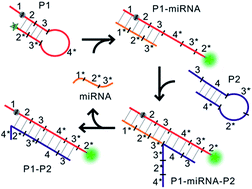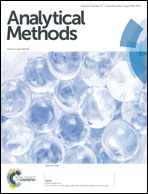An enzyme-free signal amplification strategy for sensitive detection of microRNA via catalyzed hairpin assembly
Abstract
In this work, a simple fluorescence turn-on assay is developed for a sensitive detection of microRNA (miRNA) through an enzyme-free signal amplification strategy. This design is based on the miRNA-catalyzed hairpin assembly (CHA). Two metastable hairpin DNA probes, one of which is double-labeled by a fluorophore/quencher pair with efficiently quenched fluorescence, are rationally designed to preclude unexpected hybridization events between themselves. Therefore, in the absence of miRNAs, the two types of hairpins could stably coexist in the solution with low background fluorescence because of the stringent design. When target miRNAs are added, they work as catalysts to trigger the self-assembly pathway of the two probes and initiate the cycling of CHA circuits, which results in greatly enhanced fluorescence signal. With the help of an efficient signal amplification of CHA and the low-background design of hairpin probes, at concentrations as low as 1 pM miRNA can be detected using this simple and low-cost protocol. High specificity and a wide dynamic range from 1 pM to 2 nM are also obtained. Therefore, this method may have great potential for miRNA-related biological studies.


 Please wait while we load your content...
Please wait while we load your content...